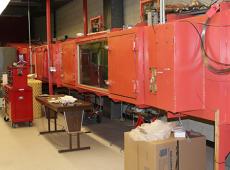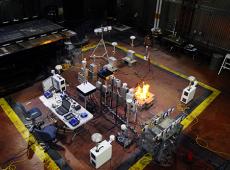The wind tunnel/combustion (WTCL) facility is used to conduct burning experiments in a controlled environment under varying temperature, humidity, and wind conditions.
The WTCL consists of three primary entities: the environmental conditioning section, the combustion laboratory and a high and low speed wind tunnels. These sections are interconnected and permit air to be conditioned and/or pass through in a number of ways.
Normal operation of the system is in a “single pass” mode. Air enters from the outside, is modified in the environmental conditioning section, and then enters the combustion laboratory through an air supply plenum. In the combustion laboratory it can be routed in four different ways: up the exhaust flue, through the high or low speed wind tunnels, or through the recirculation duct. When air passes through one of the wind tunnels in single pass mode, it is exhausted through the smoke relief duct to the outside.
The other operation mode is “recirculation”. When recirculating, the air inlets and exhaust ports are closed and the air recirculates through the preferred passage.
The single pass mode is used while conducting burning experiments since smoke needs to be exhausted outside and not re-enter the testing facility. Slightly higher air velocities can be obtained in recirculation mode.
The WTCL facility is the only facility of its kind in the world and is used to conduct experiments into wildland fire behavior, atmospheric chemistry, soil heating, fundamental fire physics, and wildland fire retardant effectiveness. The Rothermel fire spread model was derived from experiments done entirely in the WTCL. Temperature, humidity and wind speed are controlled through a computer interface where the user specifies a target set of conditions.
SPECIFICATIONS
The low speed wind tunnel has a 10 ft x 10 ft (3.0 by 3.0 meter) cross section and is capable of velocities of up to 10 ft (3.12 meters) per second. The high speed wind tunnel has a 3 ft x 3 ft (0.91 by 0.91 meter) cross section and can produce speeds up to 58 feet (17.88 meters) per second. Both tunnels are 86 feet (26.21 meters) in length. The combustion laboratory inside dimensions are 64 ft (19.60 meters) high and 40 ft (12.40 meters) square. A flue exhaust hood, located in the center of the room can be raised and lowered to accommodate the size of the fire.
The air circulated through the combustion laboratory and wind tunnels is conditioned to the desired temperature and humidity in a series of heaters, chillers, steam generators and spray nozzles. The ranges of temperature and humidity are shown below:
Relative Humidity (%) 10 – 100%
Temperature (°F) 50 – 100 °F
The range of temperature and humidity that can be achieved in the facility depends to a degree on the outside air temperature and humidity. For instance, on a summer day, when the temperature outside is 95°F, the cooling capacity of the facility could never achieve a temperature below 65°F.
The facility underwent an extensive renovation in 2017 modernizing all of the 1960’s era HVAC components, controls and computer control system. The specifications and environmental ranges of the facility remain the same.

